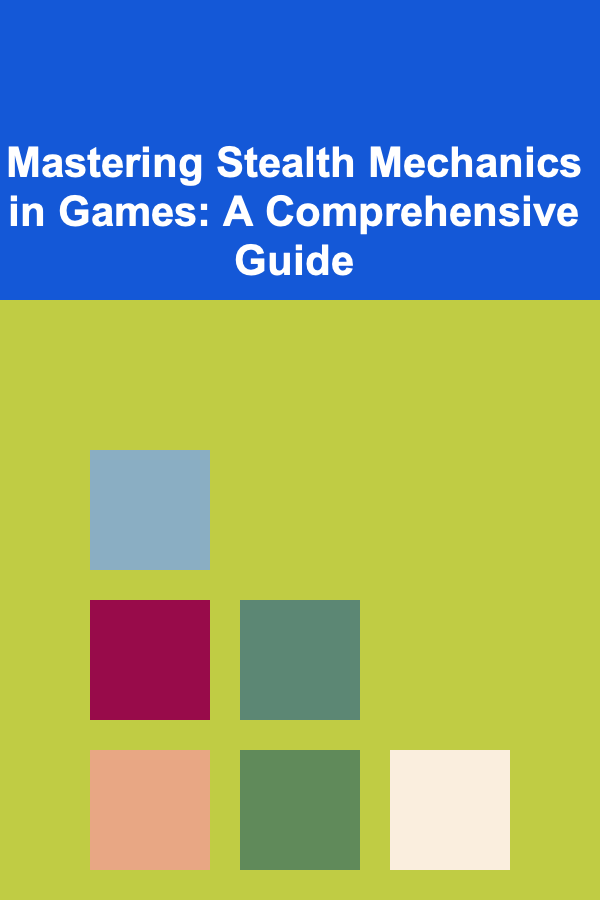
Mastering Stealth Mechanics in Games: A Comprehensive Guide
ebook include PDF & Audio bundle (Micro Guide)
$12.99$6.99
Limited Time Offer! Order within the next:

Stealth games offer a unique and often exhilarating experience, challenging players to navigate environments, outwit enemies, and accomplish objectives without being detected. From the shadows of ancient tombs to the futuristic corridors of corporate complexes, stealth mechanics provide a distinctive gameplay loop that rewards patience, observation, and cunning. But mastering stealth isn't just about crouching in a corner; it's about understanding the intricacies of the game's systems and learning to exploit them to your advantage. This comprehensive guide will delve into the core elements of stealth gameplay, exploring the mechanics, strategies, and mindset required to become a truly effective digital shadow.
Understanding the Fundamentals of Stealth
Before diving into advanced techniques, it's crucial to grasp the fundamental principles that govern stealth mechanics in most games. These principles form the bedrock upon which all successful stealth strategies are built.
The Pillars of Stealth: Visibility, Audibility, and Awareness
Most stealth games revolve around three key pillars:
- Visibility: How easily the player character can be seen. This is often influenced by factors such as lighting, camouflage, posture (standing, crouching, prone), and movement speed. Direct line of sight is the primary concern, but games often incorporate factors like peripheral vision and environmental obstructions.
- Audibility: How much noise the player character generates. Footsteps, actions like opening doors or using gadgets, and even breathing can alert enemies. Different surfaces produce different levels of noise, and moving faster increases audibility. Some games also feature reactive sound environments, where noises like alarms or music can affect enemy alertness.
- Awareness: The state of alertness of the non-player characters (NPCs). This is typically represented by a visual indicator (e.g., a meter, a color change, or a symbol above their head). Awareness progresses through stages: unaware, suspicious, alerted, and actively searching. Once fully alerted, enemies will actively pursue the player. Understanding how to manipulate enemy awareness is key to successful stealth.
These three pillars are often intertwined. For example, staying in the shadows reduces visibility, making it harder for enemies to spot you, even if you're making a small amount of noise. Similarly, distractions can draw enemies away from your location, reducing the chance of them detecting you visually or audibly.
Core Mechanics: Light and Shadow, Sound Propagation, and Enemy AI
Beyond the three pillars, several core mechanics directly impact stealth gameplay:
- Light and Shadow: One of the most fundamental elements. Areas of darkness conceal the player, making them harder to detect. Understanding how light sources function and how shadows are cast is crucial. Some games allow players to manipulate light sources (e.g., turning off lamps, shooting out spotlights) to create advantageous environments.
- Sound Propagation: How sound travels through the environment. Some games feature more realistic sound propagation, where sound can be muffled by walls or travel further in open spaces. Understanding how your actions affect the soundscape is essential for avoiding detection. Listening for enemy footsteps and vocalizations is equally important.
- Enemy AI: The behavior patterns of NPCs. This includes their patrol routes, reaction times, field of vision, and search patterns. Understanding how the AI works allows players to predict enemy behavior and plan their movements accordingly. AI often operates on a state-based system, transitioning between different alert levels based on player actions.
Each game implements these mechanics differently, so experimentation and observation are key to understanding how they function within a specific title.
Advanced Stealth Techniques: Exploiting the System
Once you've mastered the fundamentals, you can start employing advanced techniques to become a truly effective stealth operative. These techniques involve a deeper understanding of the game's mechanics and require careful planning and execution.
Mastering Movement: The Art of Silent Mobility
Movement is paramount in stealth games. The key is to move efficiently and silently, minimizing your profile and maximizing your opportunities.
- Posture Control: Switching between standing, crouching, and prone positions affects both visibility and audibility. Standing allows for faster movement and a wider field of view, but also makes you more visible. Crouching reduces your visibility and noise level, while prone offers the lowest profile but severely limits movement speed. Knowing when to use each posture is crucial.
- Footstep Management: Different surfaces generate different levels of noise. Walking on carpet is quieter than walking on metal. Some games even allow you to use "silent running" techniques, which further reduce noise but often consume stamina. Pay attention to the environment and choose your path carefully.
- Corner Peeking and Wall Hugging: These techniques allow you to scout ahead and observe enemy movements without exposing yourself. Corner peeking allows you to briefly glimpse around corners, while wall hugging keeps you concealed against walls while still allowing you to move.
- Vaulting and Climbing: Utilize verticality to your advantage. Vaulting over obstacles and climbing walls allows you to bypass enemy patrols and reach vantage points. Be mindful of the noise generated by these actions.
- Timing and Rhythm: Observe enemy patrol patterns and time your movements accordingly. Identify lulls in their movements or blind spots in their patrol routes. Maintain a consistent rhythm to avoid being detected by unpredictable movements.
Distraction and Manipulation: Controlling the Battlefield
Distraction is a powerful tool for manipulating enemy behavior and creating opportunities for infiltration.
- Noise Makers: Many stealth games feature tools specifically designed to create distractions, such as throwing rocks, using noisemakers, or triggering environmental hazards. Use these tools to lure enemies away from key areas or to create openings in their patrols.
- Environmental Exploitation: Utilize the environment to your advantage. Triggering alarms, sabotaging equipment, or creating diversions can draw enemy attention and create chaos. Look for opportunities to manipulate the environment to create distractions.
- Body Manipulation (If applicable): Some games allow you to move bodies to create distractions or to conceal your actions. This can be a risky maneuver, as it can alert other enemies, but it can also be a highly effective tactic.
- Enemy Weaknesses: Exploit enemy weaknesses, such as their susceptibility to certain types of attacks or their reliance on specific technologies. For example, some enemies might be vulnerable to headshots or easily distracted by bright lights.
Vision Cones and Patrol Patterns: Predicting Enemy Behavior
Understanding enemy vision cones and patrol patterns is essential for planning your routes and avoiding detection.
- Vision Cones: Most games represent enemy field of view with a visual cone. Understanding the shape and size of this cone is crucial for staying hidden. Pay attention to the direction the enemy is facing and avoid entering their cone of vision.
- Patrol Routes: Observe enemy patrol routes and identify their patterns. Look for predictable movements and blind spots. Use this information to plan your routes and avoid being detected. Some games feature dynamic patrol routes that change based on player actions, requiring constant adaptation.
- Reaction Times: Understand how quickly enemies react to being alerted. Some enemies have faster reaction times than others. Use this information to your advantage by exploiting their weaknesses and creating distractions.
- Vertical Awareness: Remember that enemies may also have vertical awareness. Looking up or down from ledges or balconies can expose you.
Leveraging Gadgets and Abilities: Expanding Your Arsenal
Many stealth games provide players with a variety of gadgets and abilities that can be used to enhance their stealth capabilities. Understanding how to use these tools effectively is crucial for mastering the game.
- Camouflage and Disguises: Use camouflage or disguises to blend in with the environment or to impersonate enemies. This can allow you to move freely through restricted areas without being detected.
- Invisibility and Cloaking: Utilize invisibility or cloaking devices to temporarily become undetectable. These abilities are often limited by energy or cooldown timers, so use them strategically.
- Hacking and Security Systems: Hack into security systems to disable cameras, unlock doors, or manipulate enemy patrols. This can provide you with access to restricted areas or create opportunities for infiltration.
- Non-Lethal Takedowns: Use non-lethal takedowns to neutralize enemies without killing them. This can be useful for maintaining a low profile or for completing objectives that require you to avoid killing enemies.
- Special Senses (e.g., Eagle Vision, Detective Mode): Many games provide special senses that allow you to see through walls, highlight enemies, or track their movements. These abilities can be invaluable for planning your routes and avoiding detection.
The Stealth Mindset: Patience, Observation, and Adaptation
Beyond the mechanics and techniques, mastering stealth requires a specific mindset. This mindset is characterized by patience, observation, and adaptation.
Patience: The Virtue of the Shadow
Stealth is not about rushing through levels; it's about taking your time, observing your surroundings, and planning your moves carefully. Patience is key to success. Avoid impulsive actions and wait for the right opportunity to strike. Remember that waiting for a longer period can often result in a safer and more efficient path forward.
Observation: The Power of Awareness
Pay close attention to your surroundings. Observe enemy patrol routes, identify potential distractions, and look for opportunities to exploit the environment. The more information you gather, the better equipped you will be to navigate the level successfully. Listen for audio cues, such as enemy footsteps or conversations, which can provide valuable information about their location and intentions.
Adaptation: The Key to Overcoming Challenges
No plan survives first contact. Be prepared to adapt your strategy on the fly as the situation changes. Enemy patrol routes may change, new obstacles may appear, or your cover may be blown. The ability to quickly assess the situation and adjust your approach is crucial for survival. Learn from your mistakes and don't be afraid to try different approaches. Sometimes, a failed attempt can reveal valuable information about the game's mechanics or enemy behavior.
Common Mistakes to Avoid in Stealth Games
Even with a solid understanding of stealth mechanics, it's easy to fall into common traps that can compromise your stealth and lead to detection. Here are some common mistakes to avoid:
- Rushing: As mentioned earlier, rushing is a surefire way to get caught. Take your time and plan your moves carefully.
- Ignoring Environmental Cues: Pay attention to your surroundings. Ignoring environmental cues, such as broken glass or puddles of water, can alert enemies to your presence.
- Underestimating Enemy AI: Don't underestimate the intelligence of the enemy AI. They may be more observant than you think.
- Overusing Gadgets: Gadgets can be powerful tools, but overuse can attract unwanted attention. Use them sparingly and strategically.
- Failing to Save Regularly: In stealth games, failure is often part of the learning process. Save your game frequently so you can reload if you make a mistake.
- Being Predictable: Vary your tactics to avoid becoming predictable. Enemies may learn to anticipate your moves if you use the same strategies repeatedly.
- Ignoring Sound: Sound is just as important as visibility in stealth games. Be mindful of the noise you're making and listen for audio cues from enemies.
Stealth Game Recommendations
To put your newfound knowledge to the test, here are some highly regarded stealth games across different platforms and genres:
- Metal Gear Solid Series (Konami): A pioneer of the stealth genre, known for its intricate stories, challenging gameplay, and iconic characters.
- Splinter Cell Series (Ubisoft): Focused on realistic stealth tactics and gadgets, with a emphasis on utilizing darkness and shadows.
- Hitman Series (IO Interactive): Offers a sandbox-style approach to stealth, allowing players to creatively eliminate targets using disguises and environmental interactions.
- Dishonored Series (Arkane Studios): Combines stealth with supernatural abilities, providing players with a wide range of options for infiltration and assassination.
- Deus Ex Series (Eidos Montreal): Blends stealth with cyberpunk themes and RPG elements, offering a customizable experience with multiple approaches to objectives.
- Thief Series (Eidos Montreal): Emphasizes pure stealth, challenging players to navigate environments, steal valuable items, and avoid detection at all costs.
- Mark of the Ninja (Klei Entertainment): A 2D side-scrolling stealth game with a unique art style and challenging gameplay.
Conclusion: Embracing the Shadow
Mastering stealth mechanics in games is a journey of learning, adaptation, and refinement. By understanding the fundamentals, employing advanced techniques, and cultivating the right mindset, you can transform yourself from a novice into a master of the shadows. Remember to be patient, observant, and adaptable, and don't be afraid to experiment and learn from your mistakes. With dedication and practice, you can conquer any stealth challenge and experience the thrill of outwitting your opponents without ever being seen.

How to Handle Rent Increases and Lease Renewals
Read More
How to Incorporate Metallic Accents into Your Holiday Decor
Read More
Understanding Carbon Capture and Storage in Relation to Renewables
Read More
Holiday Season Feng Shui: Creating Joyful Gatherings
Read More
Finding Jobs in a New City or Country: A Comprehensive Guide
Read More
How to Understand Different Types of Loans
Read MoreOther Products

How to Handle Rent Increases and Lease Renewals
Read More
How to Incorporate Metallic Accents into Your Holiday Decor
Read More
Understanding Carbon Capture and Storage in Relation to Renewables
Read More
Holiday Season Feng Shui: Creating Joyful Gatherings
Read More
Finding Jobs in a New City or Country: A Comprehensive Guide
Read More